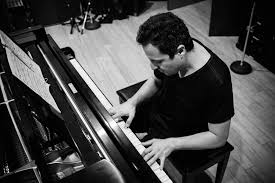
Like a flickering light in the midst of an endless sea of darkness, we find the first glimpse at a stunning piano melody in “Adagio in A Minor” as we find the others that join it in Joseph Seif’s Piano Sonata No. 1; spilling over with an untouched emotionality that cannot be replicated, even within the tracklist of this simple classical record. Much like “Piano Sonata No. 1: I. Allegro in C-Sharp Minor,” which opens the record in a blistering haze of keys, “Adagio in A Minor” floods our speakers with a dose of expressionism that you just can’t find anywhere other than inside the realm of contemporary classical music, and more specifically, the works of a brilliant pianist on the cusp of breaking through.
URL: http://www.josephseifmusic.com/
“The Fountain at Huntington Park” is perhaps the most dominantly physical track on Piano Sonata No. 1, and though it’s rivaled by its Sonata No. 2 counterpart “Piano Sonata No. 2: I. Allegro Moderato in C Minor,” I think that it currently stands as the most muscular piece currently in the Joseph Seif discography. This artist strikes me as someone who values substance over skyscraper-sized melodicism, but that doesn’t stop him from putting down some really interesting bits in both of these new records worth taking a second and third look at (especially if you enjoy the classical model, or better yet, the manipulation of it, as much as I do). He isn’t stretching himself too thin here at all – nor is he in “Piano Sonata No. 2: II. Adagio in D-Flat Major.”
Where Seif often gets himself into the most intriguing of territories is when he is working off of a minor-key melody, such as in “Piano Sonata No. 1: III. Presto in A Minor” and “Piano Sonata No. 2: III. Allegro Assai in C Minor,” both of which qualify as two of the more moving pieces I’ve had the chance to take a peek at recently. It’s clear that he isn’t interested in holding anything back from us in either of these tracks; in fact, there’s a sense of willingness on his part to put something into the ache of a melody that embodies the very essence of pain, and more importantly, the pleasure that can exist on the other side of it.
SPOTIFY: https://open.spotify.com/album/5Z2qWyBKvqaO0kT3rq3JrU
No matter whether it’s “Piano Sonata No. 1: II. Andante in D Minor” or any of the other seven tracks spread out between Piano Sonata No. 1 and 2, you’re certain to find something stimulating in the pair of new records that Joseph Seif released just this last year to acclaim from critics and fans alike. Structurally speaking, both of these sonatas are of quite the superior quality, but what they hint at for their creator is perhaps even more important than what they actually offer us in terms of cosmetic value. Seif is entering the spotlight at a crucial time in the history of classical music, and with the kind of spirit that he’s bringing to these two records, he’s sure to be a key player in its development as long as he continues to play as passionately as he has here.
Kim Muncie
